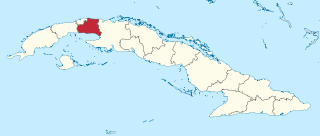This page is based on this
Wikipedia article Text is available under the
CC BY-SA 4.0 license; additional terms may apply.
Images, videos and audio are available under their respective licenses.

Havana Province was one of the provinces of Cuba, prior to being divided into two new provinces of Artemisa and Mayabeque on January 1, 2011. It had 711,066 people in the 2002 census. The largest city was Artemisa (81,209).

The National Agrarian University, also formally called National Agrarian University - La Molina (UNALM), is a public university in Lima, Peru. It is the country's best university in the fields of agricultural, biological, and forestry sciences and the only university in Peru offering degrees in meteorology. The university is organized into eight faculties which contain twelve academic departments. It is considered one of the most important higher education institutions of Peru.

Vedado is a central business district and urban neighborhood in the city of Havana, Cuba. Bordered on the east by Calzada de Infanta and Central Havana, and on the west by the Alemendares River and Miramar / Playa district, Vedado is a more modern part of the city than the areas to the east, developed in the first half of the 20th century, during the Republic period. In 2016 it was described by one commentator as the city's "most affluent" section. The main street running east to west is Calle 23, also known as "La Rampa". The northern edge of the district is the waterfront seawall known as the Malecón, a famous and popular place for social gatherings in the city. The area popularly referred to as 'Vedado' consists of the wards of Vedado, Rampa, Vedado-Malecón and Carmelo, all in the municipality of Plaza de la Revolución.
Jorge Valls Arango was a Cuban activist and poet of who spent more than two decades in prison for his opposition to Fidel Castro.
The University of Matanzas "Camilo Cienfuegos" is a university located in Matanzas, Cuba. It was founded in 1972 and is organized in 6 Faculties.
The University of Cienfuegos "Carlos Rafael Rodríguez" is a university located in Cienfuegos, Cuba.

The University "Marta Abreu" of Las Villas is an undergraduate and graduate university located in Santa Clara, Cuba founded in 1952 and having a remote campus called "Universidad de Montaña" located in Topes de Collantes, the heart of the Escambray Mountains.

The National Museum of Fine Arts of Havana in Havana, Cuba is a museum of Fine Arts that exhibits Cuban art collections from the colonial times up to contemporary generations.

The Cuban Academy of Sciences is Cuba's Academy of Sciences, with headquarters in the National Capitol building in Havana. It is described as the oldest active national academy of sciences outside Europe. The Academy is an official institution of the Cuban state with a national scope, independent and consultative in the area of science, and the successor of the former Royal Academy of Medicine, Physical and Natural Sciences of Havana, and is also attached to the Ministry of Science, Technology and the Environment.

San Carlos and San Ambrosio Seminary is a seminary in Havana, Cuba.
Escuela Nacional de Bellas Artes "San Alejandro" is the oldest and most prestigious fine arts school in Cuba. It is located in Marianao, a suburb of Havana. It was founded in 1818 at the Convent of San Alejandro by the French painter, Jean Baptiste Vermay, who was its first director. It is located today in a monumental building built in the early 1940s.

Mayabeque Province is one of two new provinces created from the former La Habana Province, whose creation was approved by the Cuban National Assembly on August 1, 2010, the other being Artemisa Province. The new provinces were enforced on January 1, 2011.

The University of Havana or UH is a university located in the Vedado district of Havana, the capital of the Republic of Cuba. Founded on January 5, 1728, the university is the oldest in Cuba, and one of the first to be founded in the Americas. Originally a religious institution, today the University of Havana has 15 faculties (colleges) at its Havana campus and distance learning centers throughout Cuba.

The University of Pedagogical Sciences "Hector Alfredo Pineda Zaldivar" (UCPETP), originally named "Héctor Alfredo Pineda Zaldívar Higher Pedagogical Institute" is a Higher Education, post-graduate and doctoral research university located in Boyeros, Havana, Cuba. It has the mission to prepare professors capable of developing high level professionals in different areas of engineering. It works to become the national leader of scientific and technical-pedagogical excellence for the improvement of the Technical and Professional Education and for its leading role of the technical careers in the rest of the pedagogical institutions.
Darío Espina Pérez was a Cuban banker, agricultural engineer, lawyer, writer, and the founder and president of La Academia Poética de Miami, a literary society established in 1989.
The University of Sancti Spíritus "José Martí Pérez" is a university located in Sancti Spíritus, Cuba. It was founded in 1976 and is organized in 4 Faculties.



















